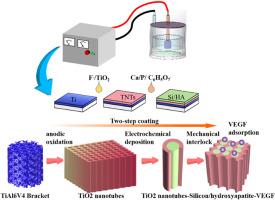多孔TC4骨支架VEGF-Si/HA-TiO2纳米管复合涂层的制备:晶体结构改善及促进血管生成和成骨再生的生物缓释
IF 4.9
3区 医学
Q1 PHARMACOLOGY & PHARMACY
Journal of Drug Delivery Science and Technology
Pub Date : 2025-09-18
DOI:10.1016/j.jddst.2025.107540
引用次数: 0
摘要
钛基多孔种植体实现了个性化的结构匹配,具有较强的承载能力,在骨修复中得到了广泛的应用。流行病学研究报告,5 - 10%的骨科和牙科种植体在手术后10-15年内失败,主要是由于成骨和血管形成不良引起的无菌性松动。为了解决这一问题,本研究提出了在钛基支架表面制备功能化涂层的策略,以促进血管和骨组织的双重再生。通过调整不同电解质的组成,成功地在二氧化钛纳米管(tnt)上制备了掺杂硅的羟基磷灰石(Si/HA)涂层,该涂层随后作为VEGF加载的平台。研究表明,在多孔微曲面上形成的TiO2纳米管平均直径为180 nm,长度为7.56 μm。通过在电解质中加入硅酸钠,与纯HA晶体相比,Si/HA晶体从不规则形态转变为相对于衬底垂直排列的柱状晶体结构,增强了复合涂层的机械联锁行为。此外,Si/HA涂层表面电荷的增加显著增强了其对VEGF的静电吸附能力,实现了可控的释放速率。28 d后,VEGF呈缓释,达到1.22 μg/ml。细胞实验证实,VEGF和Si的协同释放可显著促进骨髓间充质干细胞(BMSCs)和人脐静脉内皮细胞(HUVEC)的增殖和成骨分化。ALP、OCN和Runx2活性分析显示,VEGF-Si/HA-TNTs涂层在第7天和第14天的生物活性显著高于其他两组。这项研究为钛基种植体涂层的功能化提供了新的见解,强调了它们在骨修复中改善临床结果的潜力,特别是通过增强血管生成和成骨。本文章由计算机程序翻译,如有差异,请以英文原文为准。

Preparation of porous TC4 bone scaffold VEGF-Si/HA-TiO2 nanotube composite coating: crystal structure improvement and bio sustained release promoting angiogenesis and osteogenic regeneration
Titanium-based porous implants achieve personalized structural matching and provide strong load-bearing capacity, which has led to their widespread application in bone repair. Epidemiological studies report that 5–10 % of orthopedic and dental implants fail within 10–15 years after surgery, mainly due to aseptic loosening caused by poor osteogenesis and vascularization. To address this issue, this study proposes a strategy for preparing functionalized coatings on the surface of titanium-based scaffolds to promote the dual regeneration of vascular and bone tissues. By adjusting the composition of different electrolytes, a silicon-doped hydroxyapatite (Si/HA) coating was successfully prepared on titanium dioxide nanotubes (TNTs), which subsequently served as a platform for VEGF loading. The study showed that he TiO2 nanotubes formed on the porous micro-curved surface exhibited an average diameter of 180 nm and a length of 7.56 μm. By adding sodium silicate to the electrolyte, compared to pure HA crystals, the Si/HA crystals transformed from an irregular morphology to a columnar and vertically aligned crystal structure with respect to the substrate, which enhanced the mechanical interlocking behavior of the composite coating. Additionally, the increased surface charge of the Si/HA coating markedly enhanced its electrostatic adsorption capacity for VEGF, enabling controlled release rates. After 28 days, VEGF release followed a sustained-release profile, reaching 1.22 μg/ml. Cellular experiments confirmed that the synergistic release of VEGF and Si markedly promoted the proliferation and osteogenic differentiation of bone marrow mesenchymal stem cells (BMSCs) and human umbilical vein endothelial cells (HUVEC). ALP、OCN and Runx2 activity analysis indicated that the bioactivity of the VEGF-Si/HA-TNTs coating was significantly higher than that of the other two groups on days 7 and 14. This study provides new insights into the functionalization of titanium-based implant coatings, highlighting their potential to improve clinical outcomes in bone repair, particularly through enhanced angiogenesis and osteogenesis.
求助全文
通过发布文献求助,成功后即可免费获取论文全文。
去求助
来源期刊
CiteScore
8.00
自引率
8.00%
发文量
879
审稿时长
94 days
期刊介绍:
The Journal of Drug Delivery Science and Technology is an international journal devoted to drug delivery and pharmaceutical technology. The journal covers all innovative aspects of all pharmaceutical dosage forms and the most advanced research on controlled release, bioavailability and drug absorption, nanomedicines, gene delivery, tissue engineering, etc. Hot topics, related to manufacturing processes and quality control, are also welcomed.

 求助内容:
求助内容: 应助结果提醒方式:
应助结果提醒方式:


